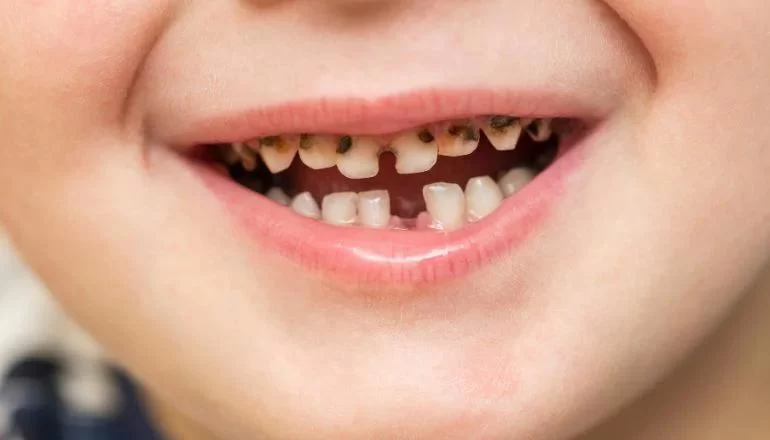
- Importance of Preventing Tooth Decay in Infants and Toddlers
- Establishing Early Oral Care Routines for Infants and Toddlers
- Nutritional and Lifestyle Influences on Infant Dental Health
- Professional Dental Guidance and Regular Monitoring
- Real-World Example of Effective Tooth Decay Prevention
- Recommended Products for Infant and Toddler Dental Care
1. Importance of Preventing Tooth Decay in Infants and Toddlers
Preventing tooth decay in infants and toddlers is a foundational step in ensuring lifelong oral health. Early childhood caries, commonly known as baby bottle tooth decay, can develop rapidly and lead to pain, infection, and difficulties with eating and speech development if not addressed early. Despite the temporary nature of baby teeth, their health affects permanent teeth alignment and overall well-being.
Many parents underestimate the importance of caring for teeth that have just emerged. However, tooth decay prevention in infants and toddlers is critical because the enamel on baby teeth is thinner and more vulnerable to acid attacks. Timely and effective care can protect these young teeth from decay, setting a healthy precedent for future dental habits.
1.1 Understanding Early Childhood Tooth Decay
Tooth decay in young children often results from prolonged exposure to sugary liquids like milk, formula, or juice. Bacteria in the mouth feed on these sugars, producing acids that erode tooth enamel. Awareness of these mechanisms helps parents take preventive steps early.
1.2 Consequences of Neglecting Infant Oral Care
Untreated tooth decay can cause pain, infections, and affect nutrition due to difficulty chewing. Moreover, severe decay might require invasive dental treatments, which can be traumatic for both child and parent.
2. Establishing Early Oral Care Routines for Infants and Toddlers
Building a consistent oral hygiene routine from infancy is essential in preventing tooth decay effectively. This routine should evolve as the child grows to accommodate new dental milestones.
2.1 Cleaning Before Teeth Erupt
Even before teeth appear, gently wiping the infant’s gums with a soft, damp cloth after feeding removes residual sugars and bacteria, laying the groundwork for healthy teeth.
2.2 Introducing Toothbrushing
Once the first tooth emerges, parents should start brushing with a tiny smear of fluoride toothpaste, about the size of a grain of rice. Using a soft-bristled toothbrush designed for infants helps clean without damaging delicate gums.
2.3 Transitioning to Toddler Care
As toddlers develop, brushing twice daily with a pea-sized amount of fluoride toothpaste and supervised flossing should become routine. Encouraging positive brushing habits at this stage promotes independence while ensuring thorough cleaning.
2.4 Avoiding Harmful Practices
Parents should avoid putting their child to bed with bottles containing anything but water, as sugary liquids pool around the teeth during sleep, dramatically increasing decay risk.
3. Nutritional and Lifestyle Influences on Infant Dental Health
Nutrition plays a pivotal role in preventing tooth decay in infants and toddlers. Choosing the right foods and establishing healthy eating habits supports oral health alongside hygiene practices.
3.1 Limiting Sugar Exposure
Frequent consumption of sugary snacks and drinks fuels bacteria growth and acid production. Parents should limit sweet treats and offer water or milk as primary beverages.
3.2 Encouraging Balanced Diets
Foods rich in calcium, phosphorus, and vitamins A, C, and D support enamel development and gum health. Introducing fresh fruits, vegetables, and dairy products aids in strengthening young teeth.
3.3 Avoiding Prolonged Bottle Feeding
Extended bottle feeding beyond 12 months, especially at night, increases decay risk. Transitioning to a cup by the toddler stage helps reduce sugary liquid exposure.
4. Professional Dental Guidance and Regular Monitoring
Along with daily care, professional dental check-ups are vital in detecting early signs of tooth decay and guiding parents on effective care strategies.
4.1 Timing the First Dental Visit
The American Academy of Pediatric Dentistry recommends scheduling a child’s first dental appointment by their first birthday. Early visits allow dentists to assess risk factors and provide tailored advice.
4.2 Routine Dental Examinations
Regular dental visits enable professional cleanings, fluoride treatments, and monitoring of tooth development. These visits also offer opportunities to reinforce healthy oral care habits for parents and children.
4.3 Professional Preventive Treatments
Sealants and topical fluoride applications may be recommended for toddlers at higher risk of decay, providing an extra layer of protection.
5. Real-World Example of Effective Tooth Decay Prevention
Take the case of Liam, a toddler whose parents noticed white spots on his teeth early on. Concerned, they visited Dentistry Toothtruth, where the dental team educated them on modifying Liam’s diet and improving brushing routines. With professional fluoride treatment and consistent home care, the early signs of decay were reversed, preventing more serious damage.
This case highlights the importance of vigilance, timely intervention, and professional support in protecting young children’s teeth effectively.
6. Recommended Products for Infant and Toddler Dental Care
For parents seeking trusted products to support their child’s dental health, Dentistry Toothtruth offers a curated range tailored to infants and toddlers. These include gentle toothbrushes, fluoride toothpaste in appropriate dosages, and oral care accessories designed for little mouths.
Partnering with Dentistry Toothtruth ensures access to expert advice and quality products, helping families establish effective care routines that prevent tooth decay from the very start.







 Dr. Maha Blaibel, DDS5.0 (6 review)
Dr. Maha Blaibel, DDS5.0 (6 review) James S Minutello, DDS and Regina D Minutello DMD MS Inc4.0 (255 review)
James S Minutello, DDS and Regina D Minutello DMD MS Inc4.0 (255 review) Kocian Family Dental5.0 (486 review)
Kocian Family Dental5.0 (486 review) Bloomington Southside Dental Care3.0 (26 review)
Bloomington Southside Dental Care3.0 (26 review) Smiles Dental Milwaukie4.0 (400 review)
Smiles Dental Milwaukie4.0 (400 review) National Dental Williston Park4.0 (287 review)
National Dental Williston Park4.0 (287 review) The Importance of Oral Health Education During Pregnancy for a Healthy Pregnancy
The Importance of Oral Health Education During Pregnancy for a Healthy Pregnancy Best Tips for Brushing Your Teeth Properly for Healthy Gums: Essential Techniques for Oral Health
Best Tips for Brushing Your Teeth Properly for Healthy Gums: Essential Techniques for Oral Health Why Skipping Dental Checkups Can Lead to Bigger Oral Health Problems
Why Skipping Dental Checkups Can Lead to Bigger Oral Health Problems Advantages of Porcelain Dental Restorations
Advantages of Porcelain Dental Restorations How Can Diabetes Cause Tooth and Gum Problems? Preventing and Managing Oral Health Issues
How Can Diabetes Cause Tooth and Gum Problems? Preventing and Managing Oral Health Issues Healthy Habits for Promoting Good Oral Health and Hygiene: Tips for a Healthy Smile
Healthy Habits for Promoting Good Oral Health and Hygiene: Tips for a Healthy Smile